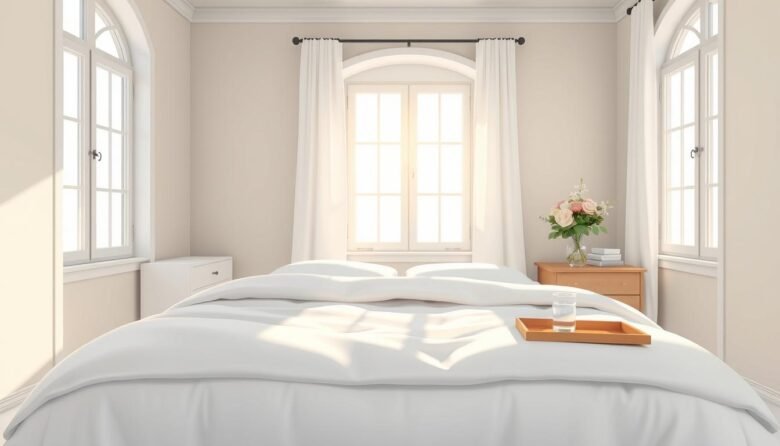Your sleeping environment plays a crucial role in your overall health and nightly rest quality. Maintaining clean linens isn’t just about appearance—it directly impacts your well-being.
Unwashed sheets accumulate dust mites, dead skin cells, and moisture from sweat. This creates an ideal environment for allergens bacteria to thrive. Regular cleaning prevents these issues effectively.
A consistent weekly routine makes odor control simple and manageable. You don’t need complex methods or expensive products to achieve excellent results.
This guide provides practical steps for washing, drying, and storing your bedding properly. These habits will maximize your bed freshness and support better sleep hygiene.
Following these practices reduces allergic reactions, minimizes skin irritation, and creates a healthier sleeping space. Simple consistent habits make all the difference.
Key Takeaways
- Weekly cleaning prevents allergen and bacteria buildup
- Proper bedding maintenance supports overall health
- Simple routines effectively control odors
- Fresh linens reduce skin irritation and allergic reactions
- Consistent habits improve sleep quality
- Proper washing and storage techniques maximize freshness
- Maintenance doesn’t require complicated methods
Why a Fresh Bed is Non-Negotiable for Your Health
Maintaining clean linens goes beyond surface-level cleanliness. It creates a foundation for physical wellness and daily comfort. Your sheets directly influence respiratory function, skin condition, and mental relaxation.
Combating Allergens Like Dust Mites and Pet Dander
Unwashed fabrics collect microscopic irritants. Dust mites thrive in warm, humid conditions. Their waste particles trigger allergic responses.
Regular washing at 130°F eliminates these pests completely. This temperature setting destroys allergen proteins effectively. High-heat cycles remove pollen and pet dander too.
Preventing the Growth of Bacteria and Fungi
Linens develop microbial colonies within days. Studies identify up to 16 fungal species in pillowcases. This microbial growth accelerates with body heat and moisture.
Bacterial buildup can cause skin infections and irritation. Those with sensitive systems face higher risks. Weekly cleaning disrupts this biological development.
How Clean Bedding Directly Improves Your Sleep Quality
Research indicates 73% of people rest better on fresh sheets. Clean fabrics reduce mental distractions during the night. They create positive associations with your sleeping space.
Fresh linens signal safety to your nervous system. This helps achieve deeper rest cycles. The psychological impact enhances overall sleep quality.
Protecting Your Skin from Irritation and Breakouts
Your face contacts pillowcases for hours nightly. Oils, sweat, and environmental pollutants transfer back to skin. This process clogs pores and worsens existing conditions.
Changing pillowcases every 3-4 days reduces breakouts significantly. This practice helps those with acne or eczema. It prevents bacterial transfer to facial skin.
Proactive maintenance supports dermatological health. Simple habits create noticeable improvements in complexion. Your skin benefits from consistent care routines.
Establish Your Weekly Bed Freshness and Odor Control Routine
Creating consistent washing habits ensures your sleeping space remains clean and inviting. Proper maintenance prevents buildup of irritants and maintains fabric quality.
The Golden Rule: How Often to Wash Sheets and Pillowcases
Most people should clean sheets every 1-2 weeks. This schedule removes accumulated skin cells and body oils effectively.
Those with allergies or heavy sweating need weekly washing. Hot water at 130°F works best for cotton and synthetic fabrics.
Summer months and intense activity require more frequent care. This prevents stubborn stains and maintains fabric integrity.
Delicate materials like silk need gentler treatment. Cooler water and mild cycles preserve these special fabrics.
Caring for Bulkier Items: Comforters, Duvets, and Mattress Pads
Comforters with protective covers need cleaning every 2-3 months. Without covers, wash them monthly to maintain cleanliness.
Fresh air revitalizes down and synthetic fills naturally. Two hours outside on sunny days eliminates moisture and odors.
Duvet covers serve as protective barriers for comforters. Wash them on the same schedule as your regular sheets.
Mattress pads require monthly washing for optimal protection. Weekly vacuuming removes surface debris and dust particles.
Thick protective pads might need professional cleaning services. Waterproof versions require immediate attention after spills.
Following these schedules extends the life of your bedding investments. Consistent care maintains both appearance and function.
Master the Best Laundry Practices for Bedding
Proper washing techniques transform your maintenance routine. They ensure fabrics remain clean, durable, and comfortable. Correct methods eliminate allergens while preserving material integrity.
Selecting the Right Water Temperature for Fabrics and Cleanliness
Hot water at 130°F works best for cotton and synthetics. This temperature kills dust mites and removes body oils effectively. It provides deep cleaning for everyday linens.
Warm settings between 90°F-110°F protect delicate materials. Silk and linen require this gentler approach. It prevents damage while still cleaning thoroughly.
Cold cycles work well for colored items and quick refreshes. They prevent fading and conserve energy. This way maintains vibrant colors longer.
Choosing Detergents and Avoiding Harmful Softeners
Regular detergents suit cotton and synthetic fabrics perfectly. They lift dirt and break down organic residues well. Follow manufacturer instructions for proper measurements.
Mild, enzyme-free formulas protect delicate items like silk. Fragrance-free options benefit sensitive skin. Color-safe bleach keeps white sheets bright.
Avoid fabric softeners that leave residue on fabrics. They reduce absorbency and trap odors over time. Use ½ cup white vinegar during rinse cycles instead.
This natural alternative softens fabrics and removes buildup. It leaves linens fresh without chemical residues. Your sheets feel softer and more comfortable.
Optimal Drying Methods: Machine vs. Line-Drying
Line-drying outdoors utilizes sunlight’s natural disinfecting power. Fresh air eliminates moisture and odors effectively. This method preserves fabric quality beautifully.
Machine drying requires low or medium heat settings. Remove items when slightly damp to prevent overdrying. Wool dryer balls improve airflow and reduce static.
For heavy comforters, pause drying every 30 minutes. Shake them to redistribute filling evenly. This ensures thorough drying without damage.
Delicate items like silk pillowcases need special care. Lay them flat on towels away from direct sunlight. This prevents shrinkage and color fading.
For persistent stains, sprinkle baking soda directly on affected areas. Let sit for 30 minutes before washing. This natural method lifts tough stains gently.
Implement Daily Habits for Sustained Freshness
Small daily actions create lasting benefits for your sleeping space. These simple practices maintain cleanliness between regular washings. They require minimal time but deliver significant results.
The Power of Airing Out Your Bed Each Morning
Pull back covers for at least 30 minutes every morning. This allows trapped moisture to evaporate completely. Proper ventilation prevents bacterial development effectively.
Fresh air circulation reduces humidity levels naturally. It inhibits allergen and microbe growth throughout the day. This daily habit transforms your sleeping environment positively.
Fluff pillows daily to redistribute filling evenly. This prevents clumping and maintains proper support. Your pillows stay comfortable and functional longer.
Remove books, electronics, and pet items before resting. This prevents debris and oil accumulation overnight. Your linens stay cleaner between wash cycles.
Using DIY Linen Sprays for a Quick Refresh
Create a natural refresher spray with simple ingredients. Combine one cup distilled water with two tablespoons vodka. Add 10-15 drops of lavender or eucalyptus essential oil.
Lightly mist sheets between regular laundering sessions. This way enhances pleasant scents without chemical residues. The alcohol content helps eliminate microorganisms naturally.
Allow the mixture to let sit for two hours before first use. This ensures proper blending of all components. Store in a dark bottle away from direct sunlight.
Change into clean pajamas after evening showers. This minimizes oil and skin cell transfer overnight. These practical tips maintain superior cleanliness effortlessly.
Incorporate these steps into your daily routine consistently. They create a welcoming space for rest each night. Your sleeping area remains inviting and properly maintained.
Tackle Spills and Stains Immediately with Spot Cleaning
Accidents happen, but quick action prevents lasting damage to your linens. Immediate treatment stops stains from setting into fabric fibers permanently. This approach maintains both appearance and material integrity effectively.
Address spills right away for optimal results. Blot liquids with clean cloths instead of rubbing. This prevents the substance from spreading further into the material.
Using Baking Soda Paste for General Stains and Odors
Create a simple cleaning paste with common household ingredients. Mix ¼ cup baking soda with a few drops of water. Adjust consistency until it forms a spreadable mixture.
Apply this mixture directly to affected areas. Gently work it into the fabric using soft bristles. Let sit for 30 minutes to break down residues completely.
Brush away dried residue after treatment. Follow with normal laundering if necessary. This method works well for various common stains.
Specific Solutions for Sweat, Blood, and Urine Stains
Sweat stains respond well to hydrogen peroxide solutions. Mix equal parts peroxide and water in a small bowl. Apply directly to affected areas and let sit for 10 minutes.
For blood marks, always use cold water initially. Rinse from the back side to push the stain out. Apply hydrogen peroxide directly and blot with clean cloths.
Urine accidents require immediate absorption first. Blot thoroughly with paper towels before treatment. Apply white vinegar and water mixture, then sprinkle baking soda over the area.
Always test cleaning solutions on hidden areas first. This prevents potential damage to delicate fabrics. Different materials may react differently to various treatments.
Prompt attention combined with proper methods preserves your linens. These techniques address common body-related issues effectively. Having a treatment plan ready ensures quick response and optimal results every time.
Choose the Right Bedding Materials for Optimal Hygiene
Choosing appropriate fabrics transforms how your body interacts with the sleeping surface. Material selection directly impacts temperature regulation and moisture management throughout the night.
Natural fibers provide superior breathability compared to synthetic alternatives. This fundamental difference affects both comfort and cleanliness in your sleeping environment.
Why Breathable Cotton and Linen Excel in Summer
Cotton remains a top choice for its exceptional breathability and soft texture. This natural fiber allows air circulation while absorbing excess moisture effectively.
Percale weave cotton offers light, crisp comfort ideal for warm nights. Its tight construction provides durability while maintaining coolness against your skin.
Linen stands out for its natural cooling properties and moisture-wicking abilities. This fabric improves with each washing, becoming softer over time.
Both materials reduce heat retention during summer months. They help maintain a comfortable temperature for your body throughout the night.
The Benefits of Hypoallergenic Bamboo Fabric
Bamboo-derived textiles offer silky-soft texture with natural temperature regulation. This material feels luxurious while providing practical health benefits.
The fabric’s antimicrobial properties resist bacterial growth naturally. This characteristic supports better hygiene without chemical treatments.
Bamboo’s breathability matches cotton while offering superior moisture management. It wicks away perspiration efficiently, keeping your skin drier.
These properties make bamboo ideal for those with sensitive skin conditions. The smooth surface minimizes friction and irritation during rest.
Materials to Avoid: Heat-Trapping Synthetics
Polyester and microfiber materials often trap heat and moisture against your skin. This creates an uncomfortable sleeping environment that can disrupt rest.
Synthetic fabrics typically lack the breathability of natural fibers. They may cause overheating and excessive sweating during the night.
These materials can accumulate body oils more readily than natural alternatives. This buildup may affect both comfort and cleanliness over time.
Choosing natural fibers supports better air circulation and moisture control. This approach enhances overall sleep quality and skin health.
Investing in quality materials extends your bedding’s lifespan significantly. Proper fabric selection creates a healthier, more comfortable resting environment every night.
Incorporate Hypoallergenic Strategies into Your Sleep Environment
Creating an allergy-resistant sleeping space requires specific protective measures. These strategies significantly reduce irritant exposure during nightly rest. They form a comprehensive defense system against common triggers.
The Essential Role of Mattress and Pillow Protectors
Zippered microfiber encasements create impermeable barriers around your sleeping surfaces. These specialized covers prevent dust mites from settling in fabric layers. They effectively trap existing allergens inside the protective casing.
These encasements shield against skin cells and moisture accumulation. They block environmental irritants from penetrating the core materials. This protection maintains a cleaner sleeping environment overall.
Quality protectors serve as the first line of defense. They preserve your mattress and pillow integrity while reducing allergy symptoms. This approach supports better respiratory health consistently.
Using a HEPA Vacuum and Dehumidifier for Allergen Control
Monthly vacuuming with HEPA-filter machines removes surface particles effectively. Focus on seams and tufts where dust mites commonly accumulate. This practice eliminates allergen buildup between deep cleanings.
Maintain bedroom humidity below 50% using a dehumidifier. Dry air conditions inhibit mite reproduction and mold development. This control method improves environmental quality significantly.
Combine these tools with protective encasements for comprehensive coverage. This way addresses both surface and embedded irritants. The system reduces sneezing, congestion, and asthma symptoms noticeably.
Those with sensitivities benefit most from these hypoallergenic approaches. They create a sanctuary free from common triggers. Consistent implementation ensures lasting comfort and improved well-being.
Address Common Mattress Issues Directly
Your mattress foundation requires specific attention to maintain cleanliness and comfort. Regular care prevents deep-seated problems from developing over time.
Direct maintenance extends the lifespan of your sleeping surface significantly. It also supports better health by reducing allergen exposure.
Common issues include accumulated particles and moisture-related concerns. These problems affect both comfort and indoor air quality.
Simple methods address these challenges effectively. They require minimal equipment but deliver noticeable results.
Effective DIY Cleaning with Vacuuming and Baking Soda
Regular vacuuming removes surface particles from your mattress. Use an upholstery attachment for best results.
Focus on seams and crevices where debris collects. These areas often harbor dust and skin cells.
For odor concerns, sprinkle baking soda across the entire surface. This natural substance absorbs unwanted smells effectively.
Let the powder sit for thirty minutes before vacuuming. This gives enough time for moisture and odor absorption.
The process refreshes your sleeping surface without harsh chemicals. It’s safe for most mattress types and materials.
When and How to Use Steam Cleaning for Deep Sanitization
Steam cleaning provides thorough disinfection for your mattress. It uses hot vapor to penetrate deep into the fabric.
This method eliminates bacteria and dust mites completely. It’s particularly useful for stubborn stains and persistent issues.
Consider steam cleaning if your mattress hasn’t been deep cleaned in over a year. Always check manufacturer instructions first.
The high-temperature steam sanitizes without chemical additives. It leaves your sleeping surface fresh and properly sanitized.
Professional services offer this treatment for optimal results. DIY units are also available for home use.
Combining regular maintenance with occasional deep cleaning keeps your mattress in excellent condition. This approach prevents permanent damage and maintains a healthy sleeping environment.
Your investment remains protected through consistent care practices. These methods ensure long-term comfort and cleanliness.
Understand the Signs Your Bedding Needs Replacing
Your linens serve you night after night, but they don’t last forever. Recognizing when to replace them maintains your comfort and supports your well-being. Timely updates ensure your sleeping environment remains healthy and inviting.
Identifying Worn-Out Sheets, Pillows, and Comforters
Sheets show wear through thinning fabric and visible damage. Look for tears, holes, or fraying seams along the edges. Loose elastics no longer provide a secure fit.
Pillows lose their supportive qualities over time. They fail to spring back when folded in half. Persistent lumps create uneven support for your head and neck.
Comforters develop compressed or uneven filling. This reduces their warmth and overall comfort level. Visible wear on the exterior signals declining performance.
Standard Lifespans for Different Bedding Components
Sheets and pillowcases typically last 2-3 years with regular use. Higher thread count cotton may serve you 5+ years. Synthetic materials generally last 1-2 years before replacement.
Pillows have varying lifespans based on their materials. Synthetic versions need replacement every 1-2 years. Memory foam maintains quality for 2-3 years with proper care.
Down and feather pillows can last 5-10 years when maintained well. Comforters generally serve 5-7 years when used with protective covers. Wool and silk comforters may last up to 10 years with careful handling.
Mattress protectors require replacement every 1-2 years. Change them when showing signs of wear or reduced effectiveness. This maintains their protective function for your sleeping surface.
Replacing worn items prevents allergen accumulation in your sleeping space. It supports better skin health and overall comfort during rest. Fresh functional bedding contributes to a healthier night routine.
Recognizing these signs ensures you always enjoy quality rest. Your body deserves clean, supportive materials every night. Proper maintenance protects your long-term health and comfort.
Dispose of Old Bedding Responsibly and Eco-Consciously
When your linens reach the end of their useful life, thoughtful disposal methods make a significant difference. Sustainable practices reduce landfill waste and support community resources effectively.
Finding the right way to handle old items protects our environment. These tips help you make responsible choices with minimal effort.
Donating Gently Used Items to Shelters
Animal shelters and homeless facilities often welcome clean, usable bedding donations. These organizations provide comfort to those in need throughout the year.
Always contact shelters beforehand to confirm their acceptance policies. Some locations have specific requirements for used items.
Colder months bring increased demand for warm bedding materials. Your donation could provide essential comfort during challenging times.
Textile Recycling and Creative Repurposing Ideas
Many retailers like H&M and IKEA offer textile recycling programs. Earth911’s online locator helps find local recycling options conveniently.
Transform old sheets into cleaning rags for household use. This simple reuse method extends material life significantly.
Worn pillowcases make excellent storage bags for seasonal items. They protect delicate clothing from dust and damage.
Create pet bedding from intact comforter sections. Our furry friends appreciate the soft, familiar materials.
Even heavily used items deserve recycling rather than disposal. This approach benefits our planet’s health long-term.
Eco-conscious disposal completes your comprehensive bedding care routine beautifully. It represents the final step in responsible home management.
Adapt Your Routine for Challenging Summer Conditions
Summer’s heat and humidity demand special attention to your bedding care. Warmer temperatures increase sweating and moisture accumulation in your sleeping area. These seasonal changes require adjusted maintenance practices.
Higher humidity levels create ideal conditions for bacterial growth. Your body produces more sweat during warm nights. This combination accelerates fabric soiling and potential issues.
Increasing Wash Frequency in Heat and Humidity
During summer months, increase sheet washing to weekly cycles. Those who sweat heavily should clean every 3-4 days. This frequency prevents sweat and oil buildup effectively.
Use warm water settings around 90°F-110°F for summer laundering. This temperature handles increased soil without damaging fabrics. Mild, color-safe detergents work best for frequent cleaning.
Pillowcases require particular attention during this time. They contact your face and absorb nighttime perspiration. More frequent changes maintain better skin health.
Strategies for Managing Night Sweats and Moisture
Shower before bed to reduce oil and sweat transfer to linens. This simple step minimizes overnight soil accumulation. Your body stays cleaner throughout the night.
Choose breathable sleepwear like cotton or bamboo fabrics. These materials allow better air circulation around your body. They minimize heat trapping and moisture retention.
Use a dehumidifier to maintain bedroom humidity below 50%. This level inhibits bacterial growth and mold development. It creates a healthier sleeping environment overall.
Air out your bed each morning for at least 30 minutes. This allows moisture evaporation and prevents mildew formation. Fresh air circulation improves the sleeping environment.
Sun pillows and duvets outdoors for natural disinfection. Ultraviolet rays eliminate microorganisms effectively. This method also removes unwanted odors naturally.
These summer-specific adjustments reduce skin irritation significantly. They prevent allergen buildup and improve sleep comfort. Adapting your routine maintains freshness despite challenging conditions.
Create a Sanctuary for Skin Health
Your nighttime routine directly impacts your complexion and dermatological well-being. The materials you choose and how you maintain them create either a healing space or an irritant source. Thoughtful selections and consistent care transform your sleeping area into a true skin sanctuary.
Selecting Skin-Friendly Fabrics and Detergents
Natural fibers provide the foundation for healthy skin during rest. Cotton, bamboo, and linen offer exceptional breathability and softness. These materials allow proper air circulation while minimizing friction against your skin.
Avoid chemically treated or heavily dyed sheets whenever possible. These treatments can trigger reactions in sensitive individuals. OEKO-TEX certified options ensure materials meet strict safety standards for skin contact.
Choose gentle, fragrance-free detergents for weekly washing. Non-biological formulas clean effectively without harsh residues. Thorough rinsing prevents leftover detergent from causing itchiness or irritation.
Fabric softeners often leave coatings that affect material performance. They can trap oils and reduce breathability over time. Your skin benefits from completely clean, residue-free fabrics.
The Importance of Frequent Pillowcase Changes
Pillowcases accumulate oils, skincare products, and environmental pollutants quickly. Changing them every 2-3 days significantly reduces breakouts for acne-prone individuals. This frequency prevents the transfer of impurities back to your skin.
Silk pillowcases offer particular advantages for sensitive skin. Their smooth surface creates less friction than cotton during the night. This reduced abrasion helps maintain skin integrity and prevents irritation.
Silk’s natural properties also minimize product absorption from your skincare routine. More active ingredients remain on your skin rather than transferring to the fabric. This maximizes the effectiveness of your evening regimen.
Showering before bed further reduces oil and pollutant transfer to your linens. Clean skin means cleaner fabrics throughout the night. This simple step supports better skin health and bedding cleanliness.
Consistent attention to these details creates a protective environment for your skin. Your complexion reflects the care you invest in your sleeping space. Proper maintenance and material choices contribute to visible improvements in skin quality and comfort.
Embrace the Lasting Benefits of a Consistently Fresh Bed
Maintaining clean linens transforms your nightly rest into a rejuvenating experience. Simple weekly habits ensure your sleeping space remains inviting and health-supporting.
Regular care reduces irritants like dust mites and allergens bacteria. This supports better respiratory function and skin condition. Your efforts contribute directly to overall health.
Natural solutions like white vinegar and baking soda enhance cleanliness. Sprinkle baking soda on stains and let sit before washing. These methods effectively manage unwanted issues.
Implementing these practices creates a sanctuary for wellness. Start your routine today for lasting comfort and vitality.



